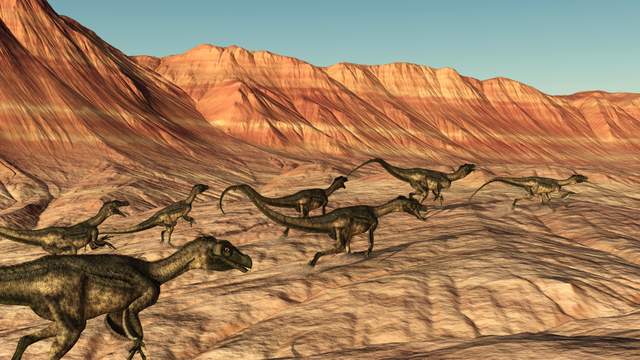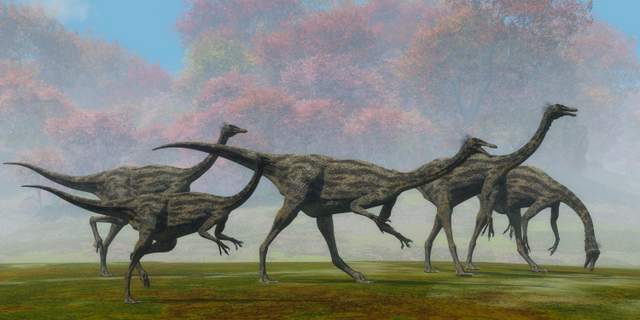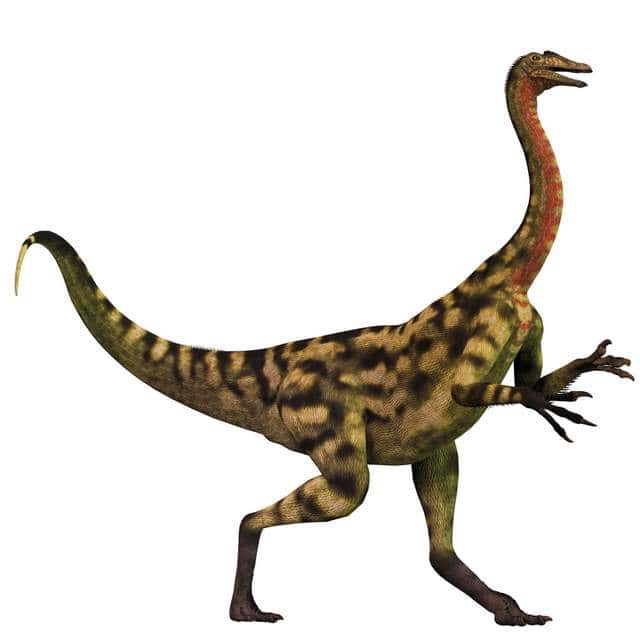What Did Omnivorous Dinosaurs Eat? In a prehistoric landscape governed by the survival of the fittest, the gastronomic flexibility of omnivorous dinosaurs was their evolutionary ace. These adaptable creatures, representing a mere sliver of the Mesozoic era’s rich tapestry, navigated a world where the line between predator and prey was as fluid as their varied diet. When the lush greenery withered, their culinary adaptability was put to the test. It makes me wonder, what did omnivorous dinosaurs eat?

What Did Omnivorous Dinosaurs Eat?
So, what did omnivorous dinosaurs eat? Omnivores were opportunistic dinosaurs that were able to eat both plants and meat. They ate seeds, plants, insects, small mammals, reptiles, and even other small dinosaurs! Their digestive tracks were able to digest both plants and animals. A surprising fact is that there is fossil evidence some omnivores even ate crustaceans.
It’s interesting to note that the dinosaur world was unique with multiple habitats and species. They were different from one another in their ways of survival, habitats, characteristics, and nutrition. As paleontologists put the puzzle pieces together from fossils, correlation to modern birds and reptiles and improved scientific techniques about what they ate and how they hunted becomes clearer every year.
Omnivorous dinosaurs, encompassing species like the Oviraptor, Ornithomimus, Therizinosaurus, Gallimimus, and Deinonychus, held a dietary flexibility in the prehistoric ecosystem. Their feeding habits comprised of a spectrum between herbivory and carnivory, materialised by their consumption of plants and meat alike.

While animal-based food sources like small mammals and insects provided them with essential proteins, a more diverse diet was maintained with the incorporation of carrion in their meals, signaling their adaptability to their environment and food availability. In contrast, their plant-based diet relied on the ingestion of fruits, berries, and leaves. This variety of plant matter, rich in dietary fiber, also contributed to a healthy digestive system.
Their dual roles as both predatory hunters and plant grazers within their ecosystems underpinned their integral niches in the prehistoric food web. This diversity in their diet provided an array of nutrients necessary for their survival.
Table of Contents
The balanced nutrition and flexible feeding habits further equipped them to adapt to their environment effectively and withstand diverse challenges. Thus, the omnivority of these dinosaurs, powered by their versatile diet, stands as a testament to their adaptability and the overall diversity within the dinosaur kingdom.
Omnivorous dinosaurs lived in many places around the world and during all three periods of the Mesozoic era. What they were like, what they eat, the advantages they had over herbivores and carnivores, and some fun facts is what we will cover in this article. Let’s get started!
Were There Omnivore Dinosaurs? What’s Special About Them and How Do They Compare To Modern-Day Omnivores?
In many ways, omnivorous dinosaurs were special not only in their ability to eat both plants and meat but also their ability to adapt and survive in different habitats. Let’s look closer at some of the details and compare them to modern-day omnivores.
Dinosaur Diet Differences
The Carnivorous Dinosaur Diet
Carnivorous dinosaurs were predatory meat-eaters and needed to catch and kill their prey. Due to this, they needed sharp teeth, resembling knives, that could stab through their meal and kill them.
However, their diet also depends on how big and fast they are. Some carnivorous dinosaurs ate only smaller animals and dinosaurs, while others like T. Rex and Allosaurus were apex predators that were excellent hunters and hunted bigger prey.
Carnivore dinosaurs had these features:
● Sharp teeth to tear flesh
● A digestive system that could streamline eating because the proteins were easier to digest
● Were fast, agile, and excellent hunters
The Herbivorous Dinosaur Diet
Herbivorous dinosaurs had a strictly plant-based diet, which was inferred from their wide, blunt teeth that could macerate plant material. Many of the plant-eaters were long-necked, which helped them reach higher into tall trees for more food.
Others were smaller such as the Stegosaurus or Triceratops that usually fed on plants, seeds, shrubs, and small trees. Duck billed herbivore dinosaurs were grazing dinosaurs.
Herbivore dinosaurs had these characteristics:
● Flat, blunt teeth for chewing vegetation
● A typically more complex digestive system able to digest bark, pine needles, and plant shoots
● Generally slower and lived in herds. Some herbivores were grazing dinosaurs
The Omnivorous Dinosaur Diet
Omnivorous dinosaurs ate both plants and animals, which gave them a variety of food choices. Depending on how big they are and how capable they are of hunting prey for food, their diet can include small insects, plants like shrubs and small trees, dinosaur eggs, small mammals and lizards, and in some cases, even small dinosaurs.
Omnivore dinosaurs had these characteristics:
● Omnivores had sharp teeth for eating meat as well as hind teeth that were blunt for chewing vegetation
● Their digestive system was capable of eating both meat and plants, based on a few of the fossils found
● The majority of Omnivores were thought to be smaller-sized, agile-moving dinosaurs, with the exception of Deinocheirus, which was large in comparison (Source)
Why Is It Better to Be an Omnivore? Some Modern-Day Animal Comparisons
If we think about the different dinosaur habitats that existed in the Mesozoic era, we can see that the habitats could be harsh to live in. Finding food in a remote desert climate with little water could be difficult if you are a herbivore dinosaur.
Seasonal flooding in floodplains areas could wipe out all the hunting grounds, and that would be life-threatening if you were a carnivore dinosaur. As an omnivore, you can adapt to the different habitats and eat both plants and meat.
Consider the modern coyote and raven, two successful modern-day desert animals. They are able to survive in desert climates, eating small rodents or vegetation if needed when the rodents aren’t plentiful. Similarly, desert areas during the Jurassic era could be challenging for dinosaurs unless they were omnivores. (Source)
Did Being an Omnivore Dinosaur Give Them an Advantage Over Carnivore and Herbivore Dinosaurs?
It’s not 100% clear if there is an evolutionary advantage to being an omnivore, besides being able to survive in different habitats and eating both meat and plants. That in itself is an advantage, but let’s look deeper.
Scientists indicate that meat is a source of protein that is easily digestible and can help animals grow faster if they have the right digestive system. Omnivores had this type of digestive system. Also, plant eaters had a complex digestive system, which omnivores had a simplified version of. It perhaps led to them being able to be more agile.
Whether these benefits led to advantages over other dinosaurs is a mystery, but let’s say it wouldn’t hurt its chances of survival.
Some Facts – What Types of Omnivore Dinosaurs Are There and How Many?
Although a bit less common and less known than strictly herbivorous and carnivorous dinosaurs, omnivorous dinosaurs definitely existed. Paleontologists have identified and classified the major groups of dinosaurs that were omnivores.

The Different Types of Omnivore Dinosaurs
Three main groups of dinosaurs were omnivores. These are Oviraptorosaurs, Ornithomimosaurs, and Troodontids.
The first main group of omnivores, the Oviraptorosaurs, were as much as 8 meters long and weighed up to 2 tons.
They had a beak and skull, which was familiar to modern-day parrots. They are considered to have been feathered dinosaurs, and ancestor of birds. In some ways, they were primitive birds.
Oviraptorosaurs:
● Were able to digest vegetation with the help of gastroliths, which are rocks in the stomach. It’s similar to modern-day birds
● Had strong beaks to break open shells of mollusks and crustaceans. It also aided in breaking shells of dinosaur eggs
● Fossil evidence of the stomach contents of a Citipati found a fossilized Troodontid skull, which indicates they might hunt and eat other smaller dinosaurs
The second group was Ornithomimosaurs, a name which means they “mimic birds.” In some ways, they looked like birds, from the beak to their digestive system and the idea that some scientists believe this species had feathers.
In some ways, these dinosaurs were the closest to being primitive birds.
● They only had three toes on each foot and only three phalanges, or fingers, on each hand.
● The beak lacked teeth, and they had weak jaw muscles.
● For digesting plants, their stomachs also had many gastroliths in their stomachs.
Troodontids were another group of dinosaurs that were omnivores. They were one of the smallest dinosaurs, but they were the most intelligent dinosaurs, and they had a bigger brain relative to their body mass.
● Troodontids were more opportunistic omnivores, meaning that they ate whatever was around them when they were hungry.
● They had loved to eat seeds, fruits, and nuts.

● If the opportunity came, they would eat dinosaur eggs, smaller dinosaurs, insects, and lizards.
Some of the Omnivore species described and listed below or in the table are more well-documented than others, due to differences in the number of discovered fossils or fossil preservation levels when they were found and studied by paleontologists. (Source)
Most of these dinosaurs listed live during the late-Cretaceous period, 66 million years ago, and existed until the mass extinction event. Paleontologists could describe the conclusions about diet by studying the teeth structures and the fossilized contents in the dinosaur’s stomach and intestines.
————————————————————————————————
Related Dinosaur Articles You Might Also Be Interested In:
Herbivore Dinosaurs – What’s So Cool About Them? (Types, Sizes, Facts)
Types of Duck Billed Dinosaurs -Names, Habitats, Nests
What Are Long Neck Dinosaurs (Types, Size, List)?
————————————————————————————————
What Was the Biggest Omnivore Dinosaur?
Deinocheirus was the biggest omnivorous dinosaur, which is also considered to be a mystery – why it was so big? Most of the other identified omnivores were small, and this one sticks out as a giant. (Source)
The Deinocheirus was a giant ostrich-looking dinosaur and ate plants and fish. It was famous due to its 8-foot-long hands. Fossils were found the first time, in Mongolia, in 1965, and paleontologists were amazed to have discovered a pair of hands that were bigger than an average man’s height. On each hand, there were only three fingers with long nails. The largest fossils measured 12-meters in length, indicating a large body size.
It had a 1-meter long skull and almost 3-meter-wide ostrich shaped hip. The beak attached to the skull was similar to modern ducks, which indicated to scientists that they lived near shallow waters for fishing and grazing small plants.
How Many Omnivorous Dinosaurs Were There? Table of Omnivore Dinosaurs
Scientists have estimated the potential number of dinosaur species that existed during the three periods of the Mesozoic era to be 1,543–2,468 (Source). As previously mentioned, paleontologists estimate that roughly 65% were herbivores, and 35% were carnivores. The omnivore dinosaurs were a small fraction, about 1%-2%. Looking at the estimation that there are over 2000 dinosaur species, 1-2% is 20-40 omnivore dinosaurs found or yet to be found.
Here is a snapshot of some of the omnivorous dinosaurs that paleontologists have studied. In the first column, I list the dinosaur. In the second column, I indicate if it was Orinthomimosaur, Troodant, or Oviraptorosaur. In the third column, I shortly describe it.
Table 1 - List of Omnivore Dinosaurs
| Omnivore Dinosaur | Omnivore Group | Where Fossils Found | Description or Facts |
|---|---|---|---|
| Shuvuuia | Oviraptorosaurs | Mongolia | Smallest omnivore dinosaur at 1.97ft (0.6m). Ate termites and other insects |
| Deinocheirus | Orinthomimosaurs | Mongolia | Known for its giant hands with 3 fingers. Was the biggest omnivore dinosaur |
| Oviraptor | Oviraptorosaurs | Mongolia | Name means "egg thief" and eggs were its main diet. Had a toothless beak |
| Khaan | Oviraptorosaurs | Mongolia | Name translates to "ruler" in Mongolian. Had diet of eggs |
| Citipati | Oviraptorosaurs | Mongolia | Bird-like dinosaur with feathers and a beak. From the Late-Cretaceous period |
| Garudimimus | Orinthomimosaurs | Mongolia | Dinosaur was 15.42ft in length (4.7m) and lived in the Late-Cretaceous period |
| Erlikosaurus | Therinzosauridae (related to Oviratorosaurs) | Mongolia | Species of dinosaur that was related to Therinzosaurus which had large claws. |
| Gallimimus | Orinthomimosaurs | Mongolia | These dinosaurs had small heads with a toothless beak. Suspected of eating mollusks |
| Orinthomimus | Orinthomimosaurs | North America | Orinthomimus had a fairly long neck and small head, with a toothless beak |
| Chirostenotes | Oviraptorosaurs | North America | These dinosaurs were small at a length of 9.5 ft (2.9m) and had narrow hands |
| Nomingia | Oviraptorosaurs | Mongolia | Ate insects and small reptiles as well as plants, from the Late-Cretaceous period |
| Sinovenator | Troontids | China | Had a long tail but short neck and were only 3.28ft (1m) in length |
| Omnivore Dinosaur | Omnivore Group | Where Fossils Found | Description or Facts |
More About Omnivorous Dinosaurs and Some Additional Facts
Determining any animal’s diet is a puzzle that scientists need to put together by examining habitats and different parts of the creatures’ anatomy. When it comes to dinosaurs, paleontologists have only fossil evidence through fossilized remains and need to make conclusions based on those same measures – habitat, and anatomy. Let’s take a look at some facts around this to fill out the knowledge of omnivore dinosaurs.
How Do Paleontologists Know a Dinosaur is an Omnivore and How Do Scientists Determine A Dinosaur’s Diet?
A dinosaur’s diet is often determined by examining their teeth or samples from its gut, depending on what is available. As a general rule, large herbivores like Brachiosaurus and other sauropods had flat teeth, kind of like vegetation shredders. The shape of the teeth was wider and blunter compared to the teeth of carnivores like Allosaurus, which had more pointed, sharp teeth that they used in killing their prey.

However, there are some dinosaurs whose teeth fall into the middle ground. If there are no samples available of their gut to determine their diet conclusively, they could be assumed to have eaten both plants and animals, or be omnivorous.
Most dinosaurs have been identified to be herbivorous, and this makes sense. The body size is also important, considering how much energy is needed for the dinosaur to live. When one eats plant material, it is closer to the primary producers, which are plants, giving more energy than eating animals, further down the food chain.
There can only be inferences derived from the available evidence. Because all we are studying are fossils that are millions of years old, we cannot yet definitively say that all dinosaurs are strictly carnivores or herbivores.
There has been some evidence of a long necked dinosaur that was predatory and carnivorous in its earlier stages and transitioned to becoming a herbivore when it grew older. It is called the Elaphrosaurus, a relative of the Tyrannosaurus rex and the Velociraptor. Its fossil was unearthed in Victoria, Australia.
Was Triceratops an Omnivore?
No, the Triceratops was not an omnivore. It was a herbivore, as inferred from its wider teeth perfect for mashing plant material. Fossil evidence points to its eating plants, bushes, and small trees that it knocked down with its horns and beak. It is most recognizable by its three horns and the wide frill around its neck.
Was Velociraptor an Omnivore?
A bipedal dinosaur lived 75 million years ago, known as Velociraptor. This dinosaur was a speedster that had a running speed of more than 64 kilometers per hour. The debate about his nature is started weather Velociraptor was an omnivore. But if we look at this speedster dinosaur’s skull anatomy, we will figure out what he was. They had a curved skull with two strong jaws. Each jaw had a strong and sharp 28 teeth.
Additionally, they had tree claws each on both front hands to flesh out their prey. By this anatomy, we can understand they were not only carnivores but also the predators. So, it is clear that Velociraptor was not an omnivore.

Final Thoughts
There is still so much to learn about the prehistoric inhabitants of our earth! It is fascinating how dinosaurs lived and interacted with their environment. Every year, scientists and paleontologists to find new fossils and continue research to further our knowledge of dinosaurs that lived millions of years ago.
When it comes to determining the type of omnivore dinosaurs that lived and what they ate, we are starting to get a better picture based on fossil findings. It’s a sure thing that there will be more surprises to come as we uncover more fossils. Who knows, maybe we will find out even more facts about how omnivore dinosaurs lived and ate.
